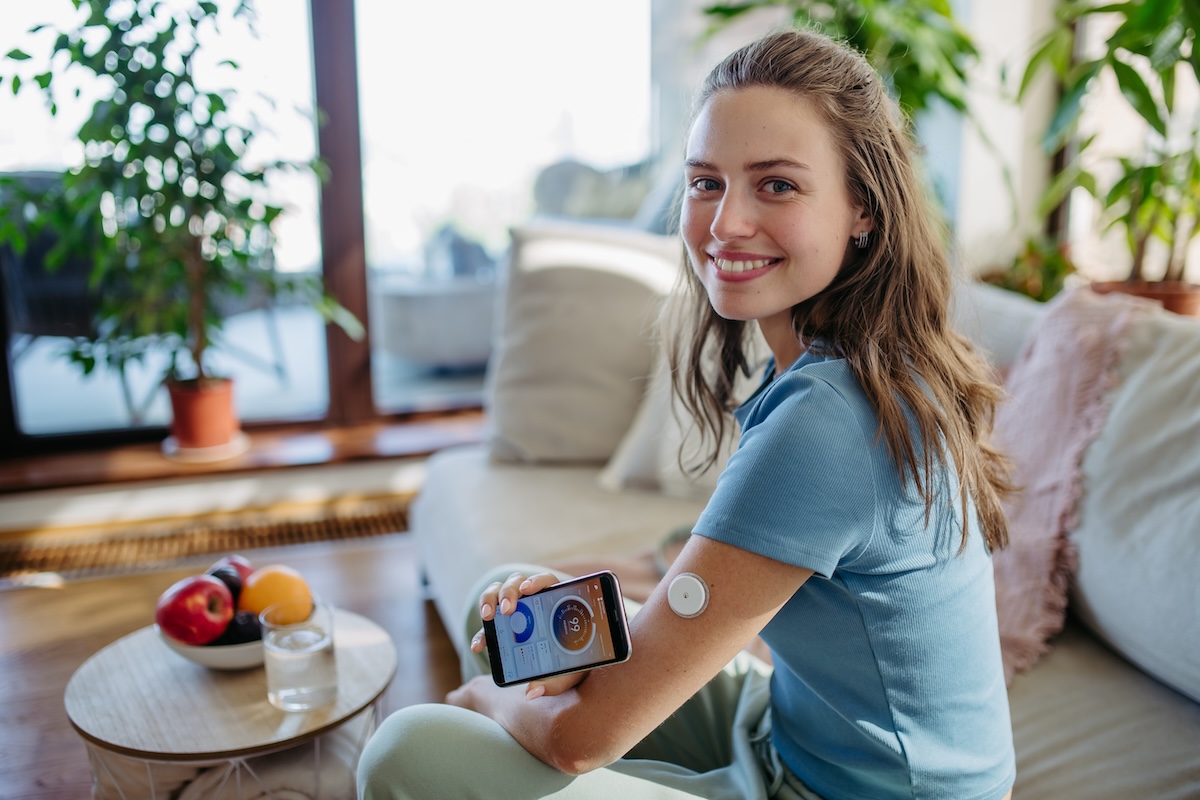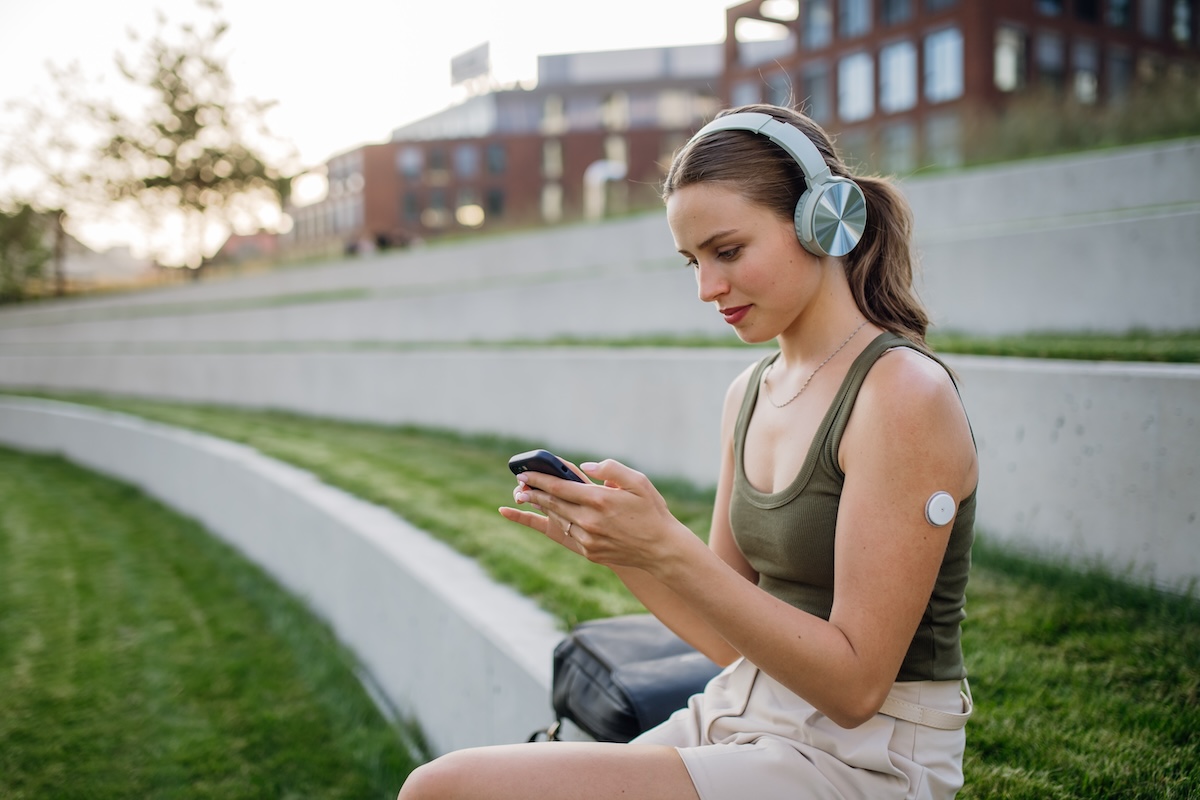What is a CGM?
A CGM, or Continuous Glucose Monitor, is a small wearable device that automatically tracks your blood sugar (glucose) levels throughout the day and night.
Here’s how it works — simply:
- A tiny sensor is placed just under the skin, usually on the upper arm.
- The sensor measures glucose in the fluid between your cells (called interstitial fluid) every few minutes.
- The data is sent to your phone or reader, where you can see your glucose level in real time along with trends and alerts if it goes too high or too low.
Unlike traditional fingersticks, which give you just a single number at one moment, a CGM shows your glucose patterns over time, such as how your body reacts to meals, activity, stress, and sleep. Instead of seeing snapshots, it’s like watching a movie of your glucose throughout the day. You can spot trends as they happen and make small, meaningful changes that support long-term health.

5 Benefits of Wearing a CGM
1. See How Your Body Responds to Food
Even when eating the same food, everyone’s body reacts differently. For example, one person’s blood sugar might stay steady after eating an apple, while another’s might spike from that same fruit. A CGM helps you see these differences in real time. By learning how your body responds to foods like rice, fruit, or coffee, you can find an eating pattern that works best for you and make choices that keep your energy steady throughout the day.
2. Catch Glucose Changes Early
Your body doesn’t always give clear warning signs when blood sugar starts to change. A CGM alerts you as soon as your glucose begins to rise or fall. This real-time feedback helps you take quick action—like going for a short walk after a meal if your blood sugar is high, or having a small snack if it’s starting to drop.

3. Reduce the Hassle of Fingersticks
Checking blood sugar the traditional way can mean several finger pricks a day, which can be uncomfortable or hard to keep up with. A CGM reduces that burden. Most systems only need an occasional fingerstick for calibration or confirmation, meaning less pain and more freedom in your daily routine.
4. Gain Confidence and Insight
A CGM doesn’t just track numbers, it helps you understand what’s behind them. You can see how your glucose changes after meals, during exercise, or even while you sleep. Over time, you’ll start to notice patterns: maybe stress raises your glucose more than you realized, or certain breakfasts keep your levels steadier than others. These insights make it easier to adjust your habits and feel confident in your choices. For many people, that awareness turns uncertainty into control and builds a stronger sense of trust with their body.
5. Support Better Long-Term Control
Because a CGM gives you more insight into your daily patterns, research shows that people who use one spend more time in their target range (typically 70–180 mg/dL) and have fewer episodes of low blood sugar. Keeping glucose levels steady over time helps protect your heart, kidneys, eyes, and nerves from diabetes-related complications.

Frequently Asked Questions (FAQ)
Here are answers to some common questions if you’re thinking about trying a CGM:
Q: Does it hurt to wear a CGM?
Most people feel only a brief pinch or pressure when inserting the sensor, similar to a fingerstick. After that, it’s usually comfortable. Mild soreness or skin irritation can happen at first but often goes away within a few hours. If pain or redness lasts, talk to your care team or replace the sensor.
Q: How long does a CGM sensor last?
It depends on the model. Most disposable sensors last 14 to 15 days.
Q: Is a prescription required to get a CGM?
If you have diabetes and plan to use insurance, you’ll usually need a prescription from your healthcare provider. If you don’t have diabetes, you can now buy newer over-the-counter versions—like Dexcom Stelo or Libre Lingo—without a prescription.
Q: How accurate is a CGM?
CGMs are highly accurate, though readings may differ slightly from fingersticks because they measure glucose in interstitial fluid (the fluid under your skin), not directly from blood. This creates a short delay—usually 5 to 15 minutes—between your blood glucose and CGM reading.
Q: Can I shower, swim, or exercise with a CGM?
Yes. Most sensors are water-resistant, so you can shower, swim, or exercise while wearing one. Just avoid scrubbing or bumping the sensor site too hard.
Q: Can people without diabetes use a CGM?
Yes. Many people use CGMs to understand how food, movement, and sleep affect blood sugar. Even without diabetes, these insights can help you build healthier habits and improve energy balance.

Takeaway
A CGM is more than a device—it’s a guide.
By showing how your daily choices affect your glucose in real time, it helps you stay proactive, informed, and confident in managing your health. If you’re curious about whether a CGM is right for you, talk with your doctor or care team to learn more.



